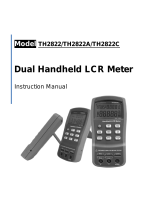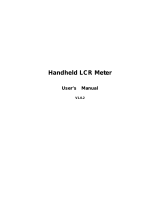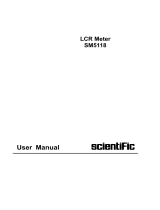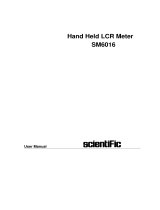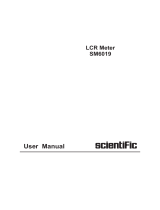Page is loading ...

100 Hz 120 Hz 1 KHz 10 KHz 100 KHz, Professional╱╱╱╱
LCR METER
Model : LCR-9184
Your purchase of this LCR
METER marks a step
forward for you into the
field of precision
measurement. Although
this LCR METER is a
complex and delicate
instrument, its durable
structure will allow many
years of use if proper
operating techniques are
developed. Please read
the following instructions
carefully and always keep
this manual within easy
reach.
OPERATION MANUAL
3, Hagavish st. Israel 58817 Tel: 972 3 5595252, Fax: 972 3 5594529 [email protected]
MRC.
10.15

TABLE OF CONTENTS
1. FEATURES..................................................................1
2. SPECIFICATIONS........................................................1
2-1 General Specifications...........................................
.
1
2-2 Electrical Specifications..........................................3
3. FRONT PANEL DESCRIPTION......................................
.
6
3-1 Display................................................................. 6
3-2 Frequency Button..................................................6
3-3 Hold Button..........................................................
.
6
3-4 L/C/R Button.........................................................6
3-5 CAL Button...........................................................
.
6
3-6 Button, RS232 Button.......................................
.
▲ 6
3-7 < Button, D/Q/θ Button.......................................
.
6
3-8 REL/%/ Button..................................................
.
▼ 6
3-9 > Button, SER/PAL Button.................................... 6
3-10 Power Button..................................................... 6
3-11 Input terminals ( pin terminals )........................... 6
3-12 Input terminals ( banana terminals )....................
.
6
3-13 DC 9V Power Adapter Input Socket......................
.
6
3-14 RS-232/USB Output Terminal............................... 6
3-15 Stand.................................................................
.
6
3-16 Battery Cover's Screws........................................
.
6
3-17 Battery Compartment/Cover.................................6
3-18 LCD backlight Button........................................... 6
3-19 Enter Button......................................................
.
6
3-20 Sorting Button....................................................6
3-21 Setup Button......................................................6
4. MEASURING PROCEDURE...........................................
.
7
4-1 Measuring procedure............................................. 7
4-2 Data hold.............................................................
.
8
4-3 Serial/Parallel........................................................8
4-4 The select of test frequency...................................9
4-5 REL /%................................................................
.
9
4-6 Sorting.................................................................
.
9
4-7 Calibration............................................................ 10
4-8 Backlight..............................................................
.
10
4-9 RS232 output........................................................10
5. POWER SUPPLY from DC ADAPTER..............................11
6. BATTERY REPLACEMENT.............................................11
7. OPTIONAL ACCESSORIES............................................11

1. FEATURES
* 19,999/1,999 counts dual LCD display.
* AutoLCR smart check and measurement.
* Serial/Parallel modes are selectable.
* Ls/Lp/Cs/Cp with D/Q/θ /ESR parameters.
* Support DCR mode 1.00 Ω to 200.0 MΩ .
* Five different test frequency are available :
100 Hz/120 Hz/1 KHz/10 KHz/100 KHz.
* Test AC signal level : 0.6 V rms typically.
* Test range : ( ex. F = 1 KHz )
L : 200.00 uH to 2000.0 H
C : 2000.0 pF to 2.000 mF
R : 20.000Ω to 200.0 MΩ
* Multi-level battery detector.
* LCD with green light backlight,easy reading.
* RS232/USB PC Computer interface.
* Can default auto power off.
2. SPECIFICATIONS
2-1 General Specifications
Display LCD size:66.8 X 52.8 mm.
LCD with green backlight ( ON /OFF )
Test frequency 100 Hz/120 Hz/1 KHz/10 KHz/100 KHz
Function L/C/R Function selector
Frequency selector
D/Q/θ /ESR selector
Sorting mode selector
Backlight
Dissipation 0.000 to 1999
factor
Quality factor 0.000 to 1999
1

θ ± 90°
measurement
Sorting ±0.25%, ±0.5%, ±1%, ±2%, ±5%
tolerance ± 10%, ± 20%, +80% -20%
mode
Calibration Open/Short calibration
Data Hold Freeze the display reading
Data output RS232/USB PC computer interface
Power off Auto shut off saves battery life or
manual off by push button
Operating 0 to 50℃℃
temperature
Operating Less then 85% R.H.
humidity
Power Supply 006P DC 9V battery
* Alkaline or Heavy duty type
DC 9V adapter input
* AC/DC power adapter is optional.
Power DC 35 mA approximately
consumption
Dimension 193 x 88 x 41mm
Weight 385 g
* meter only
Standard * Instruction manual....................... 1 PC
Accessories *
A
lligator clips...............................
.
1 Pair
Included
Optional SMD tester, SMDA-22
Accessories SMD test clip, SMDC-21
Holster, HS-03
AC to DC 9V adapter
Hard carrying case, CA-06
Soft carrying case, CA-05A
2

2-2 Electrical Specifications (23± 5 )℃
Resistance ( DCR )
Range Accuracy Remark
20 Ω ± ( 0.5% + 5d ) After calibration
200 Ω ± ( 0.5% + 5d )
2 KΩ ± ( 0.5% + 5d )
20 KΩ ± ( 0.5% + 5d )
200 KΩ ± ( 0.5% + 5d )
2 MΩ ± ( 0.5% + 5d ) After calibration
20 MΩ ± ( 1% + 5d ) After calibration
200 MΩ ± ( 2% + 5d ) After calibration
Resistance ( Rp/Rs )
Range Accuracy Accuracy Remark
100 Hz/120 Hz 1000 Hz
20 Ω ± ( 1% + 5d ) ± ( 1% + 5d ) After calibration
200 Ω ± ( 0.5% + 5d ) ± ( 0.5% + 5d )
2 KΩ ± ( 0.5% + 5d ) ± ( 0.5% + 5d )
20 KΩ ± ( 0.5% + 5d ) ± ( 0.5% + 5d )
200 KΩ ± ( 0.5% + 5d ) ± ( 0.5% + 5d )
2 MΩ ± ( 1% + 5d ) ± ( 1% + 5d ) After calibration
20 MΩ ± ( 1% + 5d ) ± ( 2% + 5d ) After calibration
200 MΩ ± ( 2% + 5d ) ± ( 5% + 5d ) After calibration
Range Accuracy Accuracy Remark
10 KHz 100 KHz
20 Ω ± ( 1% + 5d ) ± ( 2% + 5d ) After calibration
200 Ω ± ( 0.5% + 5d ) ± ( 0.5% + 5d )
2 KΩ ± ( 0.5% + 5d ) ± ( 0.5% + 5d )
20 KΩ ± ( 0.5% + 5d ) ± ( 0.5% + 5d )
200 KΩ ± ( 0.5% + 5d ) ± ( 0.5% + 5d )
2 MΩ ± ( 1% + 5d ) ± ( 2% + 5d ) After calibration
20 MΩ ± ( 2% + 5d ) ------------------- After calibration
3

Remark :
* If the impedance is lar
g
er than 10 KΩ , Rp is shown on the displa
y.
* If the impedance is less than 10 KΩ , Rs is shown on the display.
* If intend to obtain the accurate value, please test the component
into the " Pin terminals " ( 3-11, Fig. 1 ) or tested via optional
SMD tester, SMDA-22 or SMD test clip, SMDC-21.
Capacitance ( Cp/Cs ) : D 0.1≦
Range Accuracy Accuracy Remark
100 Hz/120 Hz 1000 Hz
20 pF ± ( 2% + 5d ) ± ( 1% + 5d ) After calibration
200 pF ± ( 1% + 5d ) ± ( 1% + 5d ) After calibration
2000 pF ± ( 0.8% + 5d ) ± ( 0.8% + 5d ) After calibration
20 nF ± ( 0.5% + 5d ) ± ( 0.5% + 5d )
200 nF ± ( 0.5% + 5d ) ± ( 0.5% + 5d )
2000 nF ± ( 0.5% + 5d ) ± ( 0.5% + 5d )
20 uF ± ( 0.5% + 5d ) ± ( 0.5% + 5d )
200 uF ± ( 0.5% + 5d ) ± ( 0.5% + 5d ) After calibration
2000 uF ± ( 1% + 5d ) ± ( 1% + 5d ) After calibration
20 mF ± ( 2% + 5d ) ------------------- After calibration
Range Accuracy Accuracy Remark
10 KHz 100 KHz
20 pF ± ( 1% + 5d ) ± ( 1% + 5d ) After calibration
200 pF ± ( 0.5% + 5d ) ± ( 0.5% + 5d ) After calibration
2000 pF ± ( 0.5% + 5d ) ± ( 0.5% + 5d ) After calibration
20 nF ± ( 0.5% + 5d ) ± ( 0.5% + 5d )
200 nF ± ( 0.5% + 5d ) ± ( 0.5% + 5d )
2000 nF ± ( 0.5% + 5d ) ± ( 0.5% + 5d )
20 uF ± ( 0.8% + 5d ) ± ( 0.8% + 5d )
200 uF ± ( 1% + 5d ) ------------------- After calibration
4

Remark :
* If the impedance is lar
g
er than 10 KΩ , Cp is shown on the display
.
* If the impedance is less than 10 KΩ , Cs is shown on the display.
* If intend to obtain the accurate value, please test the component
into the " Pin terminals " ( 3-11, Fig. 1 ) or tested via optional
SMD tester, SMDA-22 or SMD test clip, SMDC-21.
Inductance ( Lp/Ls ) : D 0.1≦
Range Accuracy Accuracy Remark
100 Hz/120 Hz 1000 Hz
20 uH ± ( 1% + 5d ) ± ( 1% + 5d ) After calibration
200 uH ± ( 1% + 5d ) ± ( 1% + 5d ) After calibration
2000 uH ± ( 0.8% + 5d ) ± ( 0.8% + 5d )
20 mH ± ( 0.5% + 5d ) ± ( 0.5% + 5d )
200 mH ± ( 0.5% + 5d ) ± ( 0.5% + 5d )
2000 mH ± ( 0.5% + 5d ) ± ( 0.5% + 5d )
20 H ± ( 0.5% + 5d ) ± ( 0.5% + 5d )
200 H ± ( 0.5% + 5d ) ± ( 0.8% + 5d )
2000 H ± ( 1% + 5d ) ------------------- After calibration
Range Accuracy Accuracy Remark
10 KHz 100 KHz
20 uH ± ( 1% + 5d ) ± ( 1% + 5d ) After calibration
200 uH ± ( 0.8% + 5d ) ± ( 0.8% + 5d ) After calibration
2000 uH ± ( 0.5% + 5d ) ± ( 0.5% + 5d )
20 mH ± ( 0.5% + 5d ) ± ( 0.5% + 5d )
200 mH ± ( 0.5% + 5d ) -------------------
2000 mH ± ( 0.5% + 5d ) -------------------
Remark :
* If the impedance is lar
g
er than 10 KΩ , Lp is shown on the display
.
* If the impedance is less than 10 KΩ , Ls is shown on the display.
* If intend to obtain the accurate value, please test the component
into the " Pin terminals " ( 3-11, Fig. 1 ) or tested via optional
SMD tester, SMDA-22 or SMD test clip, SMDC-21.
5

3. FRONT PANEL DESCRIPTION
3-1 Disp
l
ay
3-2 Frequency Button
3-3 Ho
ld
Button
3-4 L
/
C
/
R Button
3-5 CAL Button
3-6 Button, RS232 Button ▲
3-7 < Button, D
/
Q
/θ
Button
3-8 REL
/
%
/
Button▼
3-9 > Button, SER
/
PAL Button
3-10 Power Button
3-11 Input termina
l
s
(
pin termina
l
s
)
3-12 Input termina
l
s
(
b
anana termina
l
s
)
3-13 DC 9V Power A
d
apter Input Soc
k
et
3-14 RS-232
/
USB Output Termina
l
3-15 Stan
d
3-16 Battery Cover
'
s Screws
3-17 Battery Compartment
/
Cover
3-18 LCD
b
ac
kl
i
gh
t Button
3-19 Enter Button
3-20 Sortin
g
Button
3-21 Setup Button
6

4. MEASURING PROCEDURE
4-1 Measuring procedure
1)Power on by pressing the " power on/off key ", the all
segments of LCD will be ON for 2 seconds﹒
2)The default mode is AUTO LCR smart mode and the
default test frequency is 1 KHz.
3)In order to extend the battery life﹐it is recommended
to use the external power supply and the APO setting (
Auto power off setting ).﹒When all function button do
not be push within 5 minutes﹐the system will launch
the alarm buzzer beep at three times before the
power-off state﹒
4)When AUTO/L/C/R function selection button ( L/C/R ) is
pushed﹐the main test mode could be selected
sequentially:
Auto-LCR mode Auto-L mode→→
Auto-C mode Auto-R mode→→
DCR mode Auto-LCR mode.→
The default test mode is Auto LCR mode which
could check the type of impedance smartly and enter
to the L/C/R measurement mode automatically﹒The
secondary parameter will follow the L/C/R
measurement﹒
When Auto-L or Auto-C mode is selected, the
impedance measurement is auto ranging.
The primary LCD display will show the inductance or
capacitance of DUT ( device under testing ). The
secondary LCD display will show the quality ( Q ) or
dissipation ( D ) factor.
7

The phase angel ( θ ) or equivalent resistance ( ESR )
can also be shown by pushing the PARAMETER ( D/Q/θ )
keypad to choose D/Q/θ /ESR﹒When Auto-R(ACR
mode) or DCR mode is selected﹐the secondary
parameter is omitted﹒
Note 1 :
When Auto LCR mode is active﹐the secondary
parameter will show the equivalent resistance
in parallel mode ( Rp ) to replace the D factor if
the C measured value of DUT ( device under
testing ) is less then 5 pF﹒
Note 2 :
At Auto LCR mode only﹒During Auto R mode
or DCR mode﹐the secondary parameter is not
available﹒
4-2 Data hold
During the measurement﹐push the HOLD key to stop
the reading of DUT ( device under testing ) on primary
display.
Push the HOLD key again to cancel the hold mode and
original measurement mode﹒
4-3 Serial/Parallel
When any L/C/R function mode is selected, the default
measurement in serial or parallel mode is auto selected
and the AUTO segment will be shown on LCD display.
It depends on the total equivalent impedance measured.
If the impedance is larger than 10KΩ , parallel mode will
be set and Lp/Cp/Rp will be shown on the display. If it is
less than 10KΩ , serial mode will be set and Ls/Cs/Rs will
be shown on the display. When SER/PAL key is pushed,
the impedance measurement will be set in serial mode or
in parallel
8

4-4 The select of test frequency
When FREQ key is pushed, the test frequency will be
changed sequentially. There are five different test
frequencies ( 100Hz/120Hz/1KHz/10KHz/100KHz ) can be
selected﹒The LCR impedance scale range are depended on
the test frequency, See the specifications.
4-5 REL /%
The REL /% mode help the user to make a relative value of
the component . At first, select the function to inductors,
capacitors, resistors ( push L/C/R button ), then put under
test DUT ( device under testing ) side, LCD will be shown
the testing value. Until tested value is stable, push REL
button, LCD will appear and 0.0%. This testing is the△
first analytic value as a bench mark, the next DUT are
compared with the first percentage. Then push the REL/%
button, the indicator will be flashing, LCD will be shown△
the first value and the comparison percentage.
* Press REL/% button 2 seconds continuously will≧
exit this function.
4-6 Sorting
The sorting mode could help the user to make a quick
sort for a bunch of components. Push Sort key to the
sorting mode which will be set to 2000 digits display
automatically. If the LCD reading is OL or less than 200
counts, the SORT key is not available. The primary display
to show PASS or FAIL status depends on whether the
impedance measured exceeds tolerance range. The current
measurement result will be shown on secondary display.
When sorting mode is active, push SETUP keypad to
modify the reference value, range and the tolerance
setting sequentially﹒If the target is reached, push
ENTER keypad to confirm it. Use the direction keypads(
///)to change the target data easily. The↑↓←→
reference value setting is available from 20 to 1999 counts.
9

The tolerance range setting selection :
± 0.25% ± 0.5% ± 1% ± 2% ± 5%→ →→→
± 10% ± 20% +80% -20%→→ →
The default tolerance is ± 1%﹒
* Press Sorting button once will exit this function.
4-7 Calibration
In order to improve the accuracy for high/low
impedance, it is recommended to do OPEN/SHORT
calibration mode before the measurement. Push CAL key
larger than 2 seconds to start the open/short calibration
procedure :
OPEN ready OPEN calibration SHORT ready→→
SHORT calibration.→
During open or short calibration processing, the
30-second countdown will be shown on LCD panels.
If the calibration procedure is finished, the PASS or FAIL
symbol will be shown on the primary display. If the
PASS symbol appear on for both OPEN and SHORT
modes, the calibration data will be saved to external
EEPROM after push CAL key again
4-8 Backlight
When user push BKLIT button ( LCD backlight Button ),
the backlight driver will be active﹒Push the BKLIT button
again to disable the backlight driver﹒
4-9 RS232 output
When you want to send the measurement value to the PC
( computer ), push the RS232 key to start a 9600 bps
RS232 transmission active﹒Push the RS232 button again
to cancel the transmission﹐When RS232 output port is
transmitting, a RS232 indicator of LCD segment will be active.
10

5. POWER SUPPLY from DC
ADAPTER
The meter also can supply the power supply from the
DC 9V power adapter ( optional ). Insert the plug of
power adapter into " DC 9V Power Adapter Input Socket ".
6. BATTERY REPLACEMENT
When the lower left of LCD display show
" "
﹐it is
necessary to replace the battery.
However, in-spec﹒measurement may still be made for
several hours after low battery indicator appears before the
instrument become inaccurate﹒When the display
show " batt " and the power will be shut down.
7. OPTIONAL ACCESSORIES
SMD TESTER
Model : SMDA-22
* Optional SMD tester for LCR-9184, LCR-9183.
* Useful tool for SMD components ( Resistor,
Capacitor,Inductor ) LCR value measurement.
11

SMD TEST CLIP
Model : SMDC-21
* Optional SMD test clip for LCR-9184,LCR-9183.
* Useful test clip for SMD components ( Resistor,
Capacitor,Inductor ) LCR value measurement.
12
MRC-10.15 LCR-9184
/

